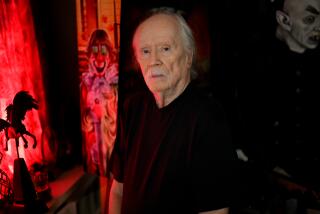FILM : Lon Chaney’s Legendary Phantom
- Share via
Horror was well-suited for the silent movie. The naturally alien quality of the silents--with their slightly off speed, pushy mood music, primitive lighting and exaggerated performances--always welcomed the grotesque.
A few directors knew how to exploit the medium for eerie results. Robert Wiener created the first nightmarish psychodrama, “The Cabinet of Dr. Caligari” (1919), and F. W. Murnau’s expressionistic “Nosferatu” (1922) gave us an idea of what blood-sucking was all about. Rupert Julian followed with “The Phantom of the Opera” (1925), for many years considered the apex of film terror.
“Phantom,” which screens late Saturday night at the Fullerton Museum Center in honor of Halloween, became a legend almost immediately. The newspapers of the day reported that women fainted, children bawled and grown men stepped outside for fresh air after the famous unmasking scene. Whether or not those reports are apocryphal, the movie eventually did take on a cult cachet so enduring that it inspired several remakes (most bad or ho-hum) and (of all things) a boffo-socko Broadway musical.
Who knows what “Phantom’s” first star, Lon Chaney, would have thought of all this. We do know, though, that he was unabashedly proud of his own performance. It may be Chaney’s best, although his ability to provoke both fear and sympathy as the twisted bell-ringer in the original “The Hunchback of Notre Dame” makes the choice a tough one.
Reflecting the style of the day, Chaney employed a heightened physicality to convey emotions and danger. It’s striking how he used his body to reveal the Phantom’s pride and also his dementia in the film’s early stages, before he’s unmasked and our attention dwells on his face. As he is shrouded in his cape, we see the carriage of a nobleman devolve into the skulk of a beast.
Even later, Chaney resists mugging, although he does assume many of the faces and postures typical of the genre. The Phantom’s ability to generate fear comes not only from his shocking appearance but also from his wildly disturbed passion for Christine.
Chaney’s acting is restrained compared to that of his co-star, Mary Philbin. As Christine, she throws up a gloriously goofy silent movie performance almost delirious in its excess: One moment she’s the Love Zombie of the Opera; the next, she’s the Hysteric of the Opera.
There are other nutty curlicues in this “Phantom”--what’s the deal with the pirouetting ballerina in the beginning scenes?--but it’s all redeemed by several vivid passages. Julian uses shadow for both effect and metaphor, as we’re first introduced to the Phantom by his silhouette and, later, the dancers and one of his dangling victims are seen as ominous shadows.
A favorite scene, nicely inventive, has the Phantom submerging himself in the underground lagoon to stalk a man, using a long stretch of bamboo as a snorkel. Even the requisite pursuit of the monster by a drooling crowd has an imaginative coda. That, as well as the rest of the movie, is underlined by Lee Erwin’s musical score, florid and melodramatic as can be.
One last note: The otherwise black-and-white “Phantom” features one of the earliest attempts at color--in the brief costume ball scene where Chaney, in a skull mask and bright red robe, mingles with party guests.
More to Read
Only good movies
Get the Indie Focus newsletter, Mark Olsen's weekly guide to the world of cinema.
You may occasionally receive promotional content from the Los Angeles Times.










